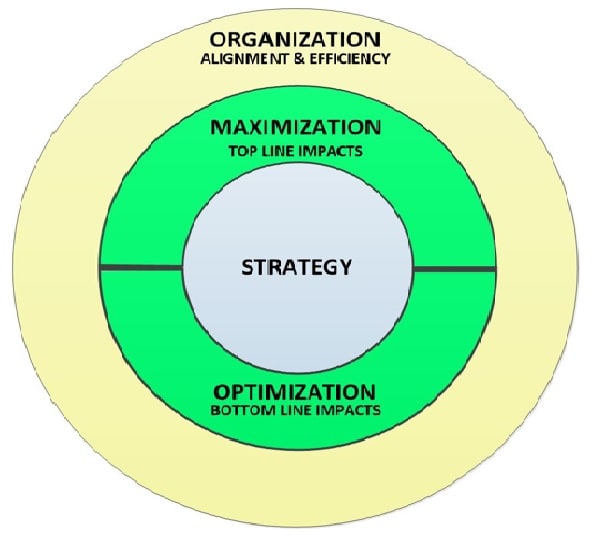In his book, The Future of Your Company Depends on It, marketing expert Al Reis illustrates the power of focus using light energy as an analogy. The sun, emitting billions of kilowatts of energy will only give us sunburn, while a laser using a tiny fraction of that amount of light energy can cut steel. One key to optimizing organizational performance is ensuring complete strategic alignment of the business goals, creating laser focus on what matters most.
That requires looking at the alignment of human resources— from the executive team to front-line employees — as well as the alignment of products, assets, and strategic decisions.
In the big picture, ineffective organizations struggle to gain results from solid strategic planning and execution while highly aligned organizations can see benefits even from weaker plans and strategy execution. Great companies find a competitive advantage in optimizing organizational structure to drive superior results.
Interims understand the importance of strategic alignment. They view people, products, services, processes, technology, systems, methodologies, and other assets as investments that must yield a meaningful ROI and drive efficient operations and ever-increasing sales.
How an Interim Executive Can Help
Interims are change management experts who are accustomed to entering situations where there is some degree of organizational dysfunction. As a result, they are experienced at understanding organizational dynamics, separating performers from excuse makers, and ultimately getting all of the stakeholders working toward a common goal: to execute the company’s vision.
To do that, an interim executive will:
Assess Asset Alignment
A solid strategy and clear plans for optimizing the bottom line and maximizing top-line revenue provide a framework for continued excellence and innovation. To achieve the strategic goals of the organization, interim executives will look at the following main areas:
- People – Bringing the right people into the company, aligning them powerfully for accountability, and providing them with a road map to strategic priorities is the way to make high-performing people feel valued and successful and get their buy-in to the business strategy. In short, business performance depends upon having the right people in the right seats doing the right tasks.
- Processes – Processes that span an organization are, by nature, segmented. For example, the sales process starts with a lead, converts the lead to a customer, sells the customer a product, delivers a product, supports that product, and accounts for the sale. Those steps may span five major areas of the company. To achieve long-term goals, the organization must harmonize complex enterprise-wide processes that require participation from many different business units.
- Technology/Systems – Technology and business processes are intertwined in an inseparable way in today’s business environment. But a company’s technology-based processes are only as strong as the weakest part. It’s equally true that strong processes backed by poor technology become overly complicated over time. Likewise, incredible technology fails when the organization’s strategy fails to implement the changes needed to optimize it. Quality interims are skilled at multi-dimensional problem solving and understand that changing one part of the process or system can create a domino effect of changes and impact other systems.
- Enabling Assets – These include items like a physical plant, specialized tools, safety equipment, and the like. While not a traditional view of assets that need strategy alignment, a building or physical plant needs to yield a return based on the type and volume of products or services it supports. Interim executives look at metrics like ROI, asset utilization percentage, sales per square foot, and cycles planned vs. realized to assess asset use.
Develop and Communicate a Clear Vision
The pace of business and ever-increasing variables that need to be considered and monitored keep team members focused on the trees (their short-term deliverables) rather than the forest (the organization’s overall goal).
Interims can help create a clear vision and communicate it so that each employee understands the unique value-add their role creates for the company, which drives enthusiasm and team spirit. Oftentimes the exercise of trying to establish a crisp and clear vision teaches a company that they are not as clear and focused as they believed, a basic hurdle to the performance of all initiatives.
Refine Decision-Making
A significant source of dysfunction in organizations is an unclear decision-making process. Decision-making by committee, relitigating each decision multiple times, or always deferring to upper management to make decisions are all symptoms of a broken process. An interim executive knows that decision-making authority needs to be clear and delegated to the people in the organization closest to action.
Revamp the Reporting Structure
The accountability chart clearly shows how each function in an organization “reports up” to the top. Sometimes, particularly when people fill multiple roles within a company, individuals or functions report up to areas of the company that do not make sense.
For example, one interim COO was faced with long order backlogs at a distribution company. The accountability chart had the order processing department report up to sales because order fulfillment was considered part of the value chain. Inventory control, however, reported up to operations. The two teams had conflicting priorities and methodologies resulting in delays, inefficiencies, and finger-pointing.
Once both functions reported up to the COO, problems were resolved cooperatively and sales benefited from higher customer satisfaction due to faster turn-around time.
Enforce Accountability
As the saying goes, “If more than one person is accountable, then no one is accountable.”
While it is fine to have multiple people performing the same exact function (each is accountable for 100% of the role as defined when performing those duties), it is problematic to have two or more people sharing a role where together they are accountable for the result.
Experienced interim executives understand that and will ensure that only one person is accountable. It’s a huge opportunity for simplification and functional breakdown.
Plan For Optimal Alignment
With the assessment of overall organizational alignment complete, plans for transformation can begin. That can mean reorganizing a company’s employees, processes, systems, and supporting assets.
The challenge in reorganizing all or parts of a company is that scenarios are often “all or none,” where executing just a part of the change will not produce a meaningful result. As multi-dimensional problem solvers, interim executives tend to be skilled at helping their clients forward engineer the full scope of changes to see likely challenges.
Further, since the overall strategy seeks to accomplish results on top of individual process innovation, the new organizational structure must work on all fronts to see improvements in individual underlying processes.
As such, plans are typically created by function, detailing the performance indicators, operational changes, anticipated benefits, and any known issues or risks that need to be addressed. These plans must also include the budget for the transformation to ensure the organization is able to make it through the full execution successfully.
Execute Transformation
A quality interim executive also serves as a coach to the leadership team, helping them establish additional skills, knowledge, and operational frameworks to keep the company healthy, and gaining traction through organizational alignment.
Contact InterimExecs to learn more about how InterimExecs RED Team – an elite group of CEOs, CFOs, CIOs, and COOs – can help your company maximize results through a strong strategic planning process and better execution of your strategic plan.
———————————
This article draws on the chapter “The Interim Executive Approach” featured in X-Formation: Transforming Business Through Interim Executive Leadership, a guide to interim management written by several veteran executives on InterimExecs RED Team.
The needs of a typical organization can be broken down into four major areas, each representing an execution discipline interims practice to assess needs and take action. See the other three of the series: Optimize, Maximize, and Strategize.







